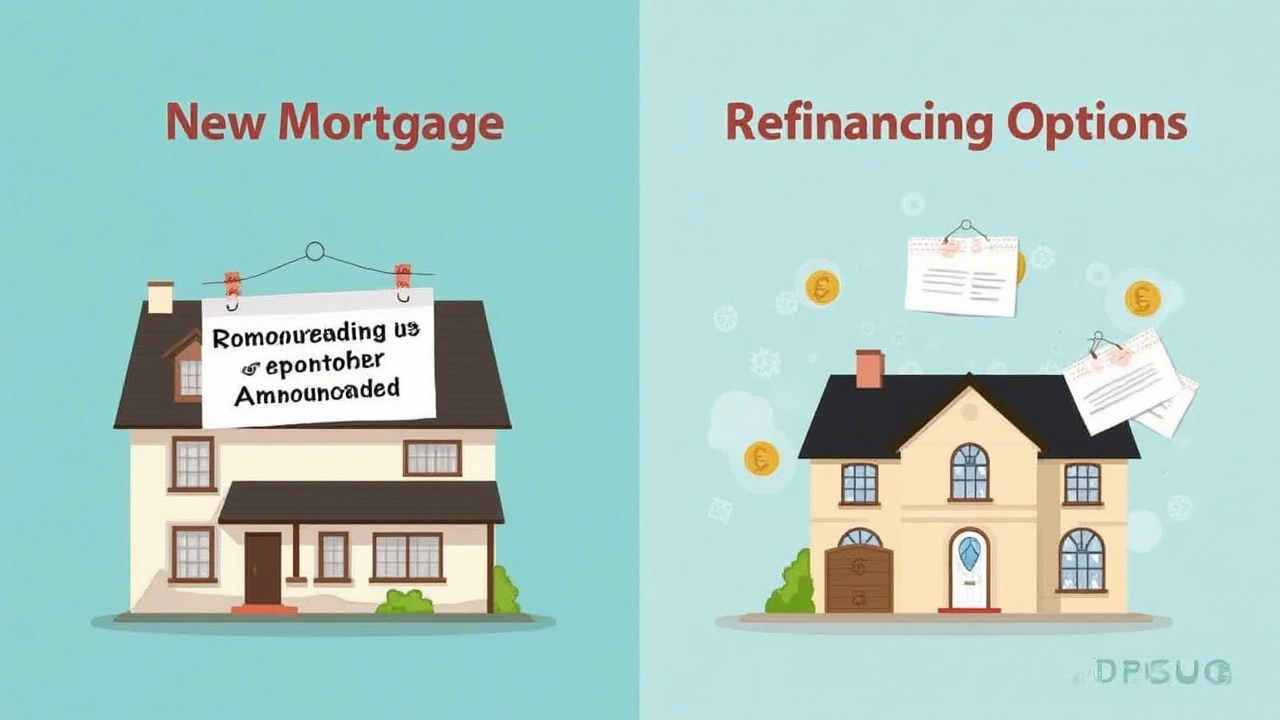Imagine you’re sipping coffee at your kitchen table, looking at your stack of bills, and considering changing your mortgage deal. You keep hearing two words: remortgaging and refinancing. They sound like twin siblings, right? But behind the scenes, these words are like cousins who grew up on opposite sides of the world. Mixing them up can be pretty confusing—and doing so might even cost you money or missed opportunities. Let’s make sense of these terms and show you how to use the right one at the right time.
Remortgaging vs. Refinancing: What Do They Really Mean?
It’s easy to think remortgaging and refinancing mean exactly the same thing. Both involve changing your current mortgage, both can help you grab a better rate, and both can mean a heap of paperwork. But their meanings change depending on where you live—in the UK, remortgaging is the go-to term, but in the US, people usually call it refinancing.
Here’s the kicker: In the UK, remortgaging usually means switching your mortgage to a new lender for a better deal, often when the initial fixed or discounted period ends. You ditch your old lender and move your debt to another bank or building society. Not always a total pain if your new lender is eager to win your business—but still, there are legal checks, property valuations, and fees (sometimes sneaky ones hidden in the small print).
In the US and Canada, refinancing covers more ground. You might stick with your lender or choose a new one. Crucially, refinancing can mean changing the loan amount, extending or shortening the loan term, or cashing out home equity (which remortgaging doesn’t always include). It’s a broader term, and, depending on your new balance and terms, your monthly payments and total interest could shift a lot.
Here’s a quick side-by-side comparison to show you how the terms play out in real life:
| Feature | Remortgaging (UK) | Refinancing (US/Canada) |
|---|---|---|
| Switching lenders | Yes (often required) | Yes or no |
| Changing loan amount | Sometimes (via extra borrowing) | Common (esp. for cash-out) |
| Changing loan term | Possible | Common |
| Associated with equity release | Less common | Very common (cash-out refinance) |
| Used term | Remortgage | Refinance |
Why does this matter for you? Because the process, costs, and benefits depend not just on what you want, but also where you live and which lender you’re dealing with. Remortgaging and refinancing can help you save money, shorten your loan, or unlock home equity—but the process to get there isn’t always a simple copy-paste. In the UK, lenders sometimes offer “product transfers,” where you stay with your current lender but switch to a new rate or product—interesting, right? But don’t let the terminology tie you in knots—the idea is pretty similar: get yourself a better deal.

When Should You Consider Remortgaging or Refinancing?
You can’t just remortgage or refinance on a whim. Lenders, whether in London or Los Angeles, usually want a compelling reason before they’ll greenlight a major change to your mortgage. So, what are the smartest times to start the process?
The hands-down most popular reason is to grab a lower interest rate. If you fixed your rate a few years ago and rates have dropped since then, moving to a new lender or refinancing your loan could save you a serious chunk of change. For example, data from the Bank of England showed over 1.5 million UK households remortgaged in 2023, the majority to lock in better rates before unexpected market hikes. That’s not pocket change we’re talking about—on a £200,000 mortgage, dropping from 5% to 4% could save you well over £1,000 a year.
In the US, refinancing boomed in 2021 due to low rates—Freddie Mac’s reports say over $2.8 trillion in mortgage originations were refinances that year. Not everyone wins, though. If you’ve been in your mortgage for a decade and you stretch your loan back out to 30 years again, you might lower your payments but end up paying more in total interest. You’ve got to do the math—grab a calculator or mortgage app before you leap in.
Another smart time to consider a change? When your introductory or teaser rate ends. In the UK, that’s usually at the end of a 2-5 year fixed period. Suddenly, you’re hit with the lender’s standard variable rate, which can be up to 1-2% higher. Ouch. Remortgaging can put you back on a low fixed or tracker deal and keep your costs predictable.
People also look to remortgaging or refinancing for other life changes. Maybe you’ve recently divorced (like my good mate Chris did last year) or you need to pay off credit card debts or a big home repair bill. In the US, that’s classic “cash-out refinance” territory—you borrow more than you owe, pocket the difference as cash, and use your equity to cover urgent expenses. In the UK, you can sometimes increase your mortgage for extra borrowing, but not all lenders will agree, and the process involves careful checks on affordability.
Here's a shortlist of top reasons to consider remortgaging or refinancing:
- Your current fixed/tracker rate is ending soon
- Current market rates are lower than your rate
- You want to borrow more money (home improvement, debt consolidation, etc.)
- You want to pay off your mortgage faster by reducing the term
- Your financial circumstances have changed (divorce, job loss, inheritance)
Quick tip: Always check for early repayment charges on your current mortgage before you leap. Sometimes those exit fees can eat up any savings you make on a better rate. And don’t forget about arrangement fees for new loans—they’re sometimes rolled into the loan, which means you’re paying interest on the fees. That’s a sneaky way lenders boost their profits (and your costs).
If you’re not sure whether remortgaging or refinancing makes sense for your situation, use an online remortgage or refinance calculator. They’re not perfect, but they’ll give you a quick glance at the numbers. Then talk to a fee-free broker or lender about your options—someone who’ll tell you the truth, not just sell you what makes them the most commission.

How Do the Processes Differ—and What Should You Watch Out For?
So, you’ve decided it’s time for a change. How do you actually go about remortgaging or refinancing? There are a few key differences in the steps, depending on your country—and a handful of landmines to watch out for so you don’t trip up along the way.
In the UK, the remortgage process generally looks like this:
- You check your current mortgage for early repayment charges or exit fees.
- Research and compare remortgage deals (look at rates, fees, incentives).
- Get a Decision in Principle (DIP) or Agreement in Principle from your chosen lender—they’ll check your credit score and basic finances.
- Apply for the new mortgage officially.
- Your new lender does a credit check, property valuation, and affordability checks. If you’ve borrowed more, they’ll want to know why.
- Appointment with a solicitor or conveyancer—they handle legal work and transfer of funds between lenders.
- After approval, your old mortgage is paid off, and your new lender becomes your mortgage holder.
It usually takes four to eight weeks from start to finish, providing everything goes smoothly. In reality, some applications crawl along for months—especially if your finances are complex, your property needs a niche valuation, or you’re self-employed. Fun fact: some UK lenders offer free legal work and free valuations to entice you, but always check the fine print.
Refinancing in the US usually involves:
- Comparing rates and loan terms among different lenders—look for the best deal, but beware of hidden fees.
- Filling out a full loan application—disclose your income, debts, assets, and property details.
- Lender orders a professional appraisal—your home’s value could mean a better or worse deal.
- Credit checks and income verification—lenders want assurance you can handle the payments.
- Underwriting—lenders dig deep into your financial history and documents.
- Signing the final loan documents at closing—includes loads of paperwork.
- Old loan is paid off, and your new lender sets up your new payments.
Refinancing generally takes 30-45 days but can run longer during busy seasons or if your case is anything but straightforward—like if you’re juggling multiple debts, have a recent bankruptcy, or your appraisal comes in lower than expected.
What’s the biggest pitfall most people hit? Not understanding all the costs. You’ll run into things like arrangement fees, valuation charges, legal fees, and—if you’re unlucky—early repayment charges from your current lender. In the US, there are origination fees, closing costs (average 2-5% of the loan), and sometimes prepayment penalties (though they’re less common now).
Another common blunder: looking only at the monthly payment. Sure, a lower payment feels good, but if you’re stretching out your mortgage from 20 years back to 30 again, you might pay tens of thousands more in interest, even with a lower rate. Always look at the “total cost of borrowing”—not just the sticker price.
There’s one more thing prospective remortgagers and refinancers get wrong: jumping at the first offer, not shopping around, and missing better deals. A survey in 2024 found that remortgaging customers who used a broker or compared at least three lenders saved an average of £375 a year more than those who stuck with their first offer. Loyalty rarely pays in the world of mortgages. Even if your current lender has been decent, it pays to shop around.
And don’t forget—your credit file matters. Any hard searches can dent your score, and lenders will dig into your credit history, especially if your income has changed due to job loss, parental leave, or self-employment. Make sure your bills are paid, your debts are as low as possible, and your accounts are in good standing before you apply.
To sum up, remortgaging and refinancing share a goal: getting the best deal for your home loan and your bank balance. But depending on your location and your needs, the details, costs, and opportunities will differ. Don’t just chase a shiny headline rate—dig into the true cost, the terms, and the traps lurking below the surface. Trust me, it’s worth the effort—just ask my spouse, Hannah, who once saved us £2,000 a year by doing a little homework before our last remortgage. Now that’s money back in your pocket where it belongs.

